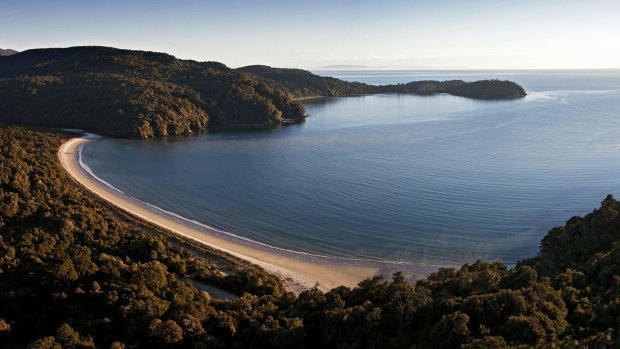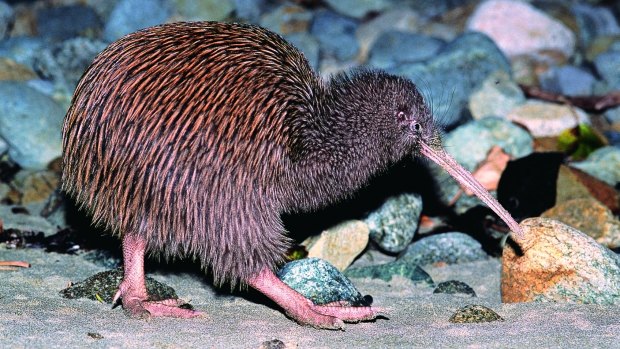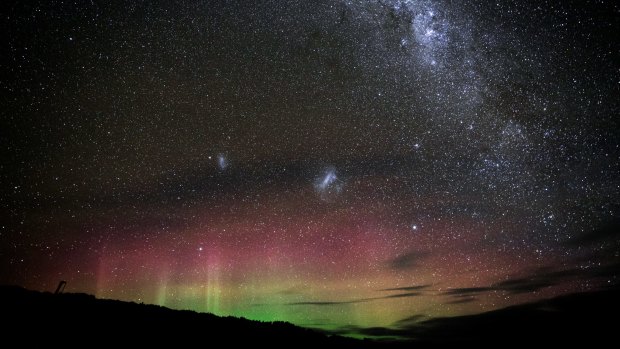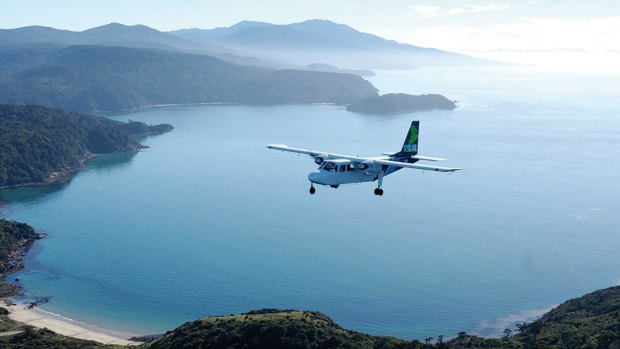This was published 4 years ago
New Zealand, Stewart Island: Search for the elusive kiwi on night time nature discovery tour
By Andrew Bain

Stewart Island is a place ruled by birds and wildlife. Around 85 per cent of the island is national park.
It's early evening in the waters off Stewart Island, and our boat is surrounded. Half-a-dozen white-capped albatross swim around the vessel, edging closer each second. Their eyes are locked in demanding stares – we're a boat, they want fish. Each one of these enormous seabirds weighs around five kilograms, and up close they loom as large as pelicans.
"If any southern royal albatross come in, they'll make these birds look like small seagulls," says Chris, the boat's skipper.
I'm not on a cruise or a wildlife-watching trip. I'm simply riding a water taxi back to Oban, the sole town on New Zealand's third island, at the end of an afternoon of hiking. Animals are hard to dodge here because Stewart Island is a place ruled by birds and wildlife. Around 85 per cent of the island is national park with copious birdlife filling its trees, and marine creatures crowding its waters.

Kiwi-spotting, Stewart Island.
With just 20 kilometres of sealed roads, the island is no place for a road trip. What draws people here instead is the wildlife and the outdoors, with the island's shores tangled with bush and interrupted by beautiful golden beaches.
Unlike the rest of New Zealand, where adventures come large and loud, Stewart Island's adventures are found in smaller parcels, such as the Rakiura Track that I've been hiking this afternoon. At 32 kilometres in length, the Rakiura Track is, along with the Routeburn Track, the shortest of New Zealand's nine Great Walks. Typically walked over three days, it loops out north from Oban, but in an afternoon it's easy to stroll the track's first and most spectacular day, winding along the coast between Lees Bay and Port William.
It sets out as a wide gravel track, with the papery limbs of fuchsia trees angling over the path, and the forest seemingly tied together by vines. New Zealand wood pigeons, as plump as hens, watch us pass from overhead branches. It's a gentle afternoon of walking – just eight flat kilometres alternating between forest and beach – before I hop aboard a water taxi back to Oban.

Aurora Australis.Credit: Rebecca Wilson Jennings
The next morning I'm on the water again, but this time paddling through Paterson Inlet with Phil Dove from Phil's Sea Kayak. The inlet is like a deep wound in Stewart Island's east coast, and is actually the southernmost of New Zealand's famous sounds, or drowned river valleys.
With 100 kilometres of coastline tucked away from the fury of the Southern Ocean, the inlet feels custom-designed to be explored in a kayak. As we paddle, little blue penguins pop to the surface of the water, and since the inlet's catchment has never seen major industry or farming, the water is as clear as gin. Metres below us, sea cucumbers, urchins and brittle starfish appear almost drawn on the water.
At the mouth of the inlet, a sea lion lounges on a sandy beach, flicking wet sand over itself to keep cool. A yellow-eyed penguin surfaces just out to sea and albatross continue to plop down like raindrops in the water around us.

Stewart Island, Rakiura.
Wildlife surrounds me, but on Stewart Island it's another creature, the kiwi, that eventually comes to dominate thoughts. Kiwis outnumber humans by about 40 to one on the island – 15,000 birds to 400 people – and there's no place in New Zealand where sightings are more likely.
A near-full moon is rising through a pink dusk sky as I board a catamaran at Oban's wharf for a Wild Kiwi Encounter tour. As darkness settles, the boat zips across the mouth of Paterson Inlet to a narrow sandy spit known as the Neck. Here, sea lions haul themselves across an isthmus rather than swim around it, and kiwis can be found more faithfully than any other place in the country. It is here that David Attenborough came to film kiwis for The Life of Birds documentary.
The catamaran moors at a wharf inside Paterson Inlet and, led by guide Johnny, we set out walking through the dark on a track across the Neck to Ocean Beach. Possums and rats scurry about the forest, but occasionally there's also the faint scratchings of a kiwi. Johnny's torchlight switches to red each time he detects a kiwi, a colour that doesn't disturb the birds and is our cue to become motionless. A hush falls over the group, and I feel a bit like I'm in the children's book We're Going on a Bear Hunt. The kiwis, however, are nowhere to be seen.
Eventually we step out on to Ocean Beach where sand hoppers, a favourite snack for kiwis, bounce about the kelp that's washed up on the sand. We walk the length of the beach, seeing recent kiwi tracks in the sand, but no birds. We return to the forest, crossing the Neck at its narrowest point to an inlet beach, where the eyes of a passing sea lion glow like rhinestones in the beams of our torches.
Faintly there's the sound of another kiwi somewhere in the bush along the beach's edge, but it's another not-quite sighting. It feels destined not to be our night. But as we wander back towards the catamaran along Ocean Beach, there are fresh tracks in the sand. Johnny gathers us together like a brood of chicks. There's a kiwi ahead on the beach. From below the kelp line, we watch as the kiwi probes and prods at the sand with its long beak, feasting on sand hoppers. At one point the bird senses us, its head and beak waving in the air to gauge any danger, but then it returns to its supper.
The kiwi is in no hurry, and neither are we. It's nearing 11pm, but nobody wants to leave. For 30 minutes we watch it feed in the red glow of the torch. "It's rare to get a sighting this good," Johnny says. I'm not sure I believe him, for there seems a Galapagos-like ease to the wildlife ways on Stewart Island.
FIVE NEW ZEALAND ISLANDS
WHITE ISLAND
An ever-boiling volcanic island off the coast from Whakatane. Boat or helicopter trips allow you wander through the sulphur and steam.
HOLE IN THE ROCK
The most famous of the 150 islands sprinkled through the Bay of Islands. Cruise through the hole on a boat trip, or view it from the end of the Cape Brett Track.
GREAT BARRIER ISLAND
Giant kauri trees and one of the world's three Dark Sky Sanctuaries, 30 minutes' flight from Auckland.
WAIHEKE ISLAND
Auckland's favourite island escape, blessed with fine wineries, beaches and eateries.
KAPITI ISLAND
Predator-free bird sanctuary, complete with kiwis, north of Wellington. Visits are only possible through tour operators Kapiti Island Eco Experience and Kapiti Island Nature Tours.
TRIP NOTES
Andrew Bain travelled courtesy of World Expeditions, Tourism New Zealand and Air New Zealand.
MORE
FLY
Air New Zealand flies to Queenstown from Melbourne up to eight times a week, and from Sydney up to nine times a week. Flights and ferries to Stewart Island depart from Invercargill and Bluff, around 2½ hours' drive south of Queenstown. See airnewzealand.com.au
TOUR
World Expeditions runs a seven-day Fiordland, Hollyford and Stewart Island Trails trip that includes two days and nights on Stewart Island. Prices start at $3450. Wild Kiwi Encounter trips ($199) are run by Stewart Island Experience. A 2½-hour guided paddle with Phil's Sea Kayak (phil_dove500@hotmail.com) costs $90. See worldexpeditions.com, stewartislandexperience.co.nz
Sign up for the Traveller Deals newsletter
Get exclusive travel deals delivered straight to your inbox. Sign up now.